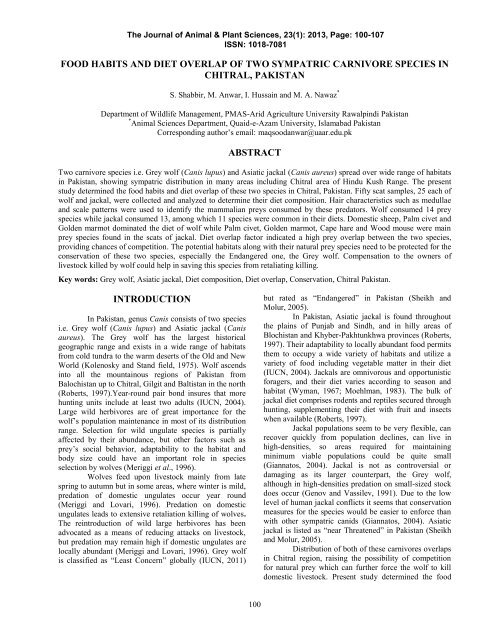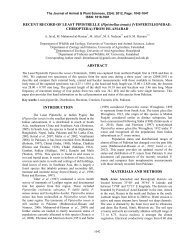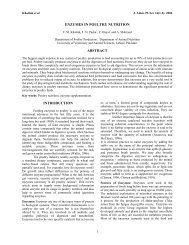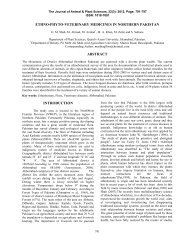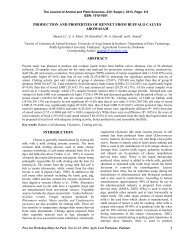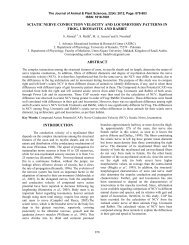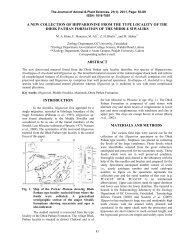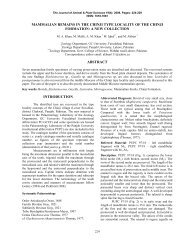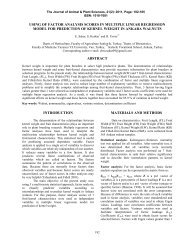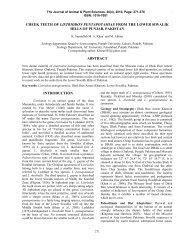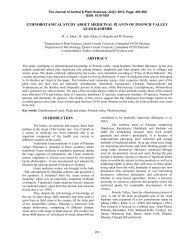food habits and diet overlap of two sympatric carnivore species in ...
food habits and diet overlap of two sympatric carnivore species in ...
food habits and diet overlap of two sympatric carnivore species in ...
Create successful ePaper yourself
Turn your PDF publications into a flip-book with our unique Google optimized e-Paper software.
Shabbir et al The Journal <strong>of</strong> Animal & Plant Sciences, 23(1): 2013, Page: J. 100-107 Anim. Plant Sci. 23(1):2013<br />
ISSN: 1018-7081<br />
FOOD HABITS AND DIET OVERLAP OF TWO SYMPATRIC CARNIVORE SPECIES IN<br />
CHITRAL, PAKISTAN<br />
S. Shabbir, M. Anwar, I. Hussa<strong>in</strong> <strong>and</strong> M. A. Nawaz *<br />
Department <strong>of</strong> Wildlife Management, PMAS-Arid Agriculture University Rawalp<strong>in</strong>di Pakistan<br />
* Animal Sciences Department, Quaid-e-Azam University, Islamabad Pakistan<br />
Correspond<strong>in</strong>g author’s email: maqsoodanwar@uaar.edu.pk<br />
ABSTRACT<br />
Two <strong>carnivore</strong> <strong>species</strong> i.e. Grey wolf (Canis lupus) <strong>and</strong> Asiatic jackal (Canis aureus) spread over wide range <strong>of</strong> habitats<br />
<strong>in</strong> Pakistan, show<strong>in</strong>g <strong>sympatric</strong> distribution <strong>in</strong> many areas <strong>in</strong>clud<strong>in</strong>g Chitral area <strong>of</strong> H<strong>in</strong>du Kush Range. The present<br />
study determ<strong>in</strong>ed the <strong>food</strong> <strong>habits</strong> <strong>and</strong> <strong>diet</strong> <strong>overlap</strong> <strong>of</strong> these <strong>two</strong> <strong>species</strong> <strong>in</strong> Chitral, Pakistan. Fifty scat samples, 25 each <strong>of</strong><br />
wolf <strong>and</strong> jackal, were collected <strong>and</strong> analyzed to determ<strong>in</strong>e their <strong>diet</strong> composition. Hair characteristics such as medullae<br />
<strong>and</strong> scale patterns were used to identify the mammalian preys consumed by these predators. Wolf consumed 14 prey<br />
<strong>species</strong> while jackal consumed 13, among which 11 <strong>species</strong> were common <strong>in</strong> their <strong>diet</strong>s. Domestic sheep, Palm civet <strong>and</strong><br />
Golden marmot dom<strong>in</strong>ated the <strong>diet</strong> <strong>of</strong> wolf while Palm civet, Golden marmot, Cape hare <strong>and</strong> Wood mouse were ma<strong>in</strong><br />
prey <strong>species</strong> found <strong>in</strong> the scats <strong>of</strong> jackal. Diet <strong>overlap</strong> factor <strong>in</strong>dicated a high prey <strong>overlap</strong> between the <strong>two</strong> <strong>species</strong>,<br />
provid<strong>in</strong>g chances <strong>of</strong> competition. The potential habitats along with their natural prey <strong>species</strong> need to be protected for the<br />
conservation <strong>of</strong> these <strong>two</strong> <strong>species</strong>, especially the Endangered one, the Grey wolf. Compensation to the owners <strong>of</strong><br />
livestock killed by wolf could help <strong>in</strong> sav<strong>in</strong>g this <strong>species</strong> from retaliat<strong>in</strong>g kill<strong>in</strong>g.<br />
Key words: Grey wolf, Asiatic jackal, Diet composition, Diet <strong>overlap</strong>, Conservation, Chitral Pakistan.<br />
INTRODUCTION<br />
In Pakistan, genus Canis consists <strong>of</strong> <strong>two</strong> <strong>species</strong><br />
i.e. Grey wolf ( Canis lupus) <strong>and</strong> Asiatic jackal ( Canis<br />
aureus). The Grey wolf has the largest historical<br />
geographic range <strong>and</strong> exists <strong>in</strong> a wide range <strong>of</strong> habitats<br />
from cold tundra to the warm deserts <strong>of</strong> the Old <strong>and</strong> New<br />
World (Kolenosky <strong>and</strong> St<strong>and</strong> field, 1975). Wolf ascends<br />
<strong>in</strong>to all the mounta<strong>in</strong>ous regions <strong>of</strong> Pakistan from<br />
Balochistan up to Chitral, Gilgit <strong>and</strong> Baltistan <strong>in</strong> the north<br />
(Roberts, 1997).Year-round pair bond <strong>in</strong>sures that more<br />
hunt<strong>in</strong>g units <strong>in</strong>clude at least <strong>two</strong> adults (IUCN, 2004).<br />
Large wild herbivores are <strong>of</strong> great importance for the<br />
wolf’s population ma<strong>in</strong>tenance <strong>in</strong> most <strong>of</strong> its distribution<br />
range. Selection for wild ungulate <strong>species</strong> is partially<br />
affected by their abundance, but other factors such as<br />
prey’s social behavior, adaptability to the habitat <strong>and</strong><br />
body size could have an important role <strong>in</strong> <strong>species</strong><br />
selection by wolves (Meriggi et al., 1996).<br />
Wolves feed upon livestock ma<strong>in</strong>ly from late<br />
spr<strong>in</strong>g to autumn but <strong>in</strong> some areas, where w<strong>in</strong>ter is mild,<br />
predation <strong>of</strong> domestic ungulates occur year round<br />
(Meriggi <strong>and</strong> Lovari, 1996). Predation on domestic<br />
ungulates leads to extensive retaliation kill<strong>in</strong>g <strong>of</strong> wolves.<br />
The re<strong>in</strong>troduction <strong>of</strong> wild large herbivores has been<br />
advocated as a means <strong>of</strong> reduc<strong>in</strong>g attacks on livestock,<br />
but predation may rema<strong>in</strong> high if domestic ungulates are<br />
locally abundant (Meriggi <strong>and</strong> Lovari, 1996). Grey wolf<br />
is classified as “Least Concern” globally (IUCN, 2011)<br />
100<br />
but rated as “Endangered” <strong>in</strong> Pakistan (Sheikh <strong>and</strong><br />
Molur, 2005).<br />
In Pakistan, Asiatic jackal is found throughout<br />
the pla<strong>in</strong>s <strong>of</strong> Punjab <strong>and</strong> S<strong>in</strong>dh, <strong>and</strong> <strong>in</strong> hilly areas <strong>of</strong><br />
Blochistan <strong>and</strong> Khyber-Pakhtunkhwa prov<strong>in</strong>ces (Roberts,<br />
1997). Their adaptability to locally abundant <strong>food</strong> permits<br />
them to occupy a wide variety <strong>of</strong> habitats <strong>and</strong> utilize a<br />
variety <strong>of</strong> <strong>food</strong> <strong>in</strong>clud<strong>in</strong>g vegetable matter <strong>in</strong> their <strong>diet</strong><br />
(IUCN, 2004). Jackals are omnivorous <strong>and</strong> opportunistic<br />
foragers, <strong>and</strong> their <strong>diet</strong> varies accord<strong>in</strong>g to season <strong>and</strong><br />
habitat (Wyman, 1967; Moehlman, 1983). The bulk <strong>of</strong><br />
jackal <strong>diet</strong> comprises rodents <strong>and</strong> reptiles secured through<br />
hunt<strong>in</strong>g, supplement<strong>in</strong>g their <strong>diet</strong> with fruit <strong>and</strong> <strong>in</strong>sects<br />
when available (Roberts, 1997).<br />
Jackal populations seem to be very flexible, can<br />
recover quickly from population decl<strong>in</strong>es, can live <strong>in</strong><br />
high-densities, so areas required for ma<strong>in</strong>ta<strong>in</strong><strong>in</strong>g<br />
m<strong>in</strong>imum viable populations could be quite small<br />
(Giannatos, 2004). Jackal is not as controversial or<br />
damag<strong>in</strong>g as its larger counterpart, the Grey wolf,<br />
although <strong>in</strong> high-densities predation on small-sized stock<br />
does occur (Genov <strong>and</strong> Vassilev, 1991). Due to the low<br />
level <strong>of</strong> human jackal conflicts it seems that conservation<br />
measures for the <strong>species</strong> would be easier to enforce than<br />
with other <strong>sympatric</strong> canids (Giannatos, 2004). Asiatic<br />
jackal is listed as “near Threatened” <strong>in</strong> Pakistan (Sheikh<br />
<strong>and</strong> Molur, 2005).<br />
Distribution <strong>of</strong> both <strong>of</strong> these <strong>carnivore</strong>s <strong>overlap</strong>s<br />
<strong>in</strong> Chitral region, rais<strong>in</strong>g the possibility <strong>of</strong> competition<br />
for natural prey which can further force the wolf to kill<br />
domestic livestock. Present study determ<strong>in</strong>ed the <strong>food</strong>
Shabbir et al J. Anim. Plant Sci. 23(1):2013<br />
composition <strong>of</strong> Grey wolf <strong>and</strong> Asiatic jackal <strong>and</strong> extent<br />
<strong>of</strong> <strong>diet</strong> <strong>overlap</strong> between these <strong>two</strong> <strong>species</strong> <strong>in</strong> Chitral area.<br />
This <strong>in</strong>formation can support their conservation efforts.<br />
MATERIALS AND METHODS<br />
Study Area: The study was conducted <strong>in</strong> Chitral Gol<br />
National Park (CGNP) <strong>and</strong> Tushi Game Reserve (TGR)<br />
<strong>in</strong> Khyber-Pakhtunkhwa prov<strong>in</strong>ce <strong>of</strong> Pakistan. Chitral<br />
Gol NP is situated at 35 o 56'N &71'40 o E, with total area<br />
101<br />
<strong>of</strong> 7,750ha (Fig. 1). Tushi GR is located close to CGNP,<br />
with an area <strong>of</strong> 1,545ha.The climate is dry temperate,<br />
characterized by hot summers <strong>in</strong> lower areas <strong>and</strong> cold<br />
summers <strong>in</strong> upper elevations. Mean annual temperature is<br />
16.8 0 C <strong>and</strong> mean annual precipitation is 445 mm (Ali,<br />
2008). Summer <strong>and</strong> autumn are dry, receiv<strong>in</strong>g barely 10-<br />
25 mm monthly ra<strong>in</strong>fall (GoNWFP <strong>and</strong> IUCN-P, 2004).<br />
Oak forest (Quercus ilex) exists up to 2,400 m elevation<br />
which grades <strong>in</strong>to coniferous forest <strong>in</strong>clud<strong>in</strong>g Cedrus<br />
deodara <strong>and</strong> P<strong>in</strong>us gerardiana at higher elevations.<br />
Fig. 1.Location <strong>of</strong> the study area <strong>in</strong> district Chitral, Pakistan.<br />
Fauna <strong>of</strong> the study area has aff<strong>in</strong>ities to<br />
Palearctic region <strong>and</strong> major <strong>species</strong> <strong>in</strong>clude; Snow<br />
leopard ( Uncia uncia), Black bear ( Ursus thibetanus),<br />
Himalayan lynx ( Lynx lynx), Grey wolf ( Canus lupus),<br />
Asiatic jackal ( Canus aureus), Markhor ( Capra<br />
falconeri), Himalayan ibex ( Capra ibex sibirica), Cape<br />
hare ( Lepus capensis), Snow cock (Tetraogallous<br />
himalayensis) <strong>and</strong> Chukar partridge ( Alectoris chukar)<br />
(GoNWFP, 2006; D<strong>in</strong> <strong>and</strong> Nawaz, 2010). Cattle, sheep<br />
<strong>and</strong> goats are the ma<strong>in</strong> domestic livestock <strong>species</strong> which<br />
are kept for meat, milk, hides, wool <strong>and</strong> for draught<br />
purposes. They graze freely on natural vegetation dur<strong>in</strong>g<br />
summer (GoNWFP <strong>and</strong> IUCN-P, 2004).<br />
Methods: Diet compositions <strong>of</strong> the target <strong>species</strong> were<br />
determ<strong>in</strong>ed through scat analysis. A total <strong>of</strong> 50 scats,<br />
25each <strong>of</strong> wolf <strong>and</strong> jackal, were collected between April<br />
2009 <strong>and</strong> December 2010 from CGNP <strong>and</strong> TGR.<br />
Identification <strong>of</strong> scats as <strong>of</strong> wolf or jackal was based<br />
ma<strong>in</strong>ly on their dimensions, shape <strong>and</strong> structure.<br />
Additional criteria <strong>in</strong>cluded the nature <strong>of</strong> scat deposit site<br />
<strong>and</strong> presence <strong>of</strong> tracks or sign <strong>of</strong> activity <strong>in</strong> nearby area.<br />
Scat samples were double-bagged, labeled, <strong>and</strong> frozen.<br />
To identify the rema<strong>in</strong>s <strong>of</strong> prey <strong>species</strong> <strong>in</strong> the scat<br />
samples, reference hairs <strong>of</strong> potential prey <strong>species</strong> found<br />
<strong>in</strong> the study area were collected (Table 1). The reference<br />
slides <strong>of</strong> hairs <strong>of</strong> potential prey <strong>species</strong> <strong>and</strong> those found <strong>in</strong><br />
the scats were prepared follow<strong>in</strong>g Lavoie (1971). The
Shabbir et al J. Anim. Plant Sci. 23(1):2013<br />
scats were washed under flow<strong>in</strong>g water <strong>and</strong> sieved<br />
through cotton cloth to remove un-necessary particles <strong>and</strong><br />
dust. Then contents were segregated <strong>in</strong>to hairs <strong>and</strong> bones.<br />
The scale patterns <strong>of</strong> hairs were prepared after (Lavoie,<br />
1971). The medullary patterns <strong>and</strong> scale replication <strong>of</strong> the<br />
hairs were observed under high power microscope ( 40x<br />
or 100x) <strong>and</strong> identification <strong>of</strong> prey <strong>species</strong> was carried<br />
out follow<strong>in</strong>g Moore et al., (1974). Microphotographs <strong>of</strong><br />
representative medulla <strong>and</strong> scale patterns <strong>of</strong> hairs were<br />
taken by OLYMPUS BH-2 microscope. The reference<br />
key was used to identify unknown hairs <strong>in</strong> scat samples<br />
<strong>and</strong> prey consumed. As an example, microphotographs <strong>of</strong><br />
hair scale pattern <strong>of</strong> four prey <strong>species</strong> (<strong>of</strong> known hair <strong>and</strong><br />
a hair found <strong>in</strong> scat sample) are given <strong>in</strong> Fig. 2.<br />
The contents <strong>of</strong> wolf <strong>and</strong> jackal scats were<br />
presented as frequency <strong>of</strong> occurrence (percentage <strong>of</strong> scats<br />
<strong>in</strong> which an item was found) <strong>and</strong> percent occurrence<br />
(number <strong>of</strong> times the hair <strong>of</strong> a given prey was found as<br />
percentage <strong>of</strong> all prey items found) <strong>of</strong> each <strong>food</strong> item.<br />
Diet <strong>overlap</strong> between the <strong>two</strong> <strong>species</strong> was estimated by<br />
calculat<strong>in</strong>g the modified Morisita <strong>in</strong>dex <strong>of</strong> <strong>overlap</strong> (Horn,<br />
1966). The <strong>in</strong>dex varies from 0.0 for completely<br />
dist<strong>in</strong>ct pairs (no <strong>food</strong> <strong>species</strong> <strong>in</strong> com mon) to 1.0 for<br />
complete <strong>overlap</strong>:<br />
1a 1b<br />
102<br />
Where x <strong>and</strong> y are frequencies <strong>of</strong> prey <strong>species</strong> <strong>in</strong> the total<br />
<strong>diet</strong> <strong>of</strong> wolf <strong>and</strong> jackal, respectively.<br />
Table 1. Animal <strong>species</strong> <strong>of</strong> study area <strong>in</strong>cluded <strong>in</strong> the<br />
hair identification key<br />
Vernacular name Scientific name<br />
Domestic goat Capra hircus<br />
Domestic sheep Ovis aries<br />
Kashmir markhor Capra falconeri<br />
cashmiriensis<br />
Common Red fox Vulpes vulpes<br />
Rhesus monkey Macaca mulatta<br />
Himalayan Black bear Ursus thibetanus<br />
Cape hare Lepus capensis<br />
Golden marmot Marmota caudata<br />
Small Kashmir fly<strong>in</strong>g squirrel Hylopetes fimbriatus<br />
Himalayan palm civet Pagum alarvata<br />
Royle’spika Ochotona roylei<br />
Royle’s Mounta<strong>in</strong> vole Alticola roylei<br />
Asiatic White-toothed shrew Crocidura pullata<br />
Grey hamster Cricetulus migratorius<br />
House mouse Mus musculus<br />
Himalayan Wood mouse Apodemus rusiges<br />
Turkestan rat Rattus turkestanicus<br />
Plate 1: Microphotographs <strong>of</strong> hair scale pattern <strong>of</strong> Cape hare (Lepus capensis): 1a) reference hair (10x40 x), 1b)<br />
hair found <strong>in</strong> scat sample (10x40x).<br />
2a 2b<br />
Plate 2: Microphotographs <strong>of</strong> hair scale pattern<strong>of</strong> Palm civet (Paguma larvata); 2a) reference hair ((10x100 x), 2b)<br />
hair found <strong>in</strong> scat sample (10x100x).
Shabbir et al J. Anim. Plant Sci. 23(1):2013<br />
3a 3b<br />
Plate 3: Microphotographs <strong>of</strong> hair scale pattern <strong>of</strong> domestic Goat (Capra hircus domesticus); 3a) reference hair<br />
((10x40 x), 3b) hair found <strong>in</strong> scat sample (10x40x).<br />
4a<br />
Plate4:Microphotographs <strong>of</strong> hair scale pattern <strong>of</strong> Golden marmot (Marmot acaudata); 4a) reference hair ((10x100<br />
x), 4b) hair found <strong>in</strong> scat sample (10x100x).<br />
Fig 2. Microphotographs <strong>of</strong> hair scale patterns <strong>of</strong> four prey <strong>species</strong> (<strong>of</strong> known hair <strong>and</strong> <strong>of</strong> hair found <strong>in</strong> scat<br />
sample).<br />
markhor (2.12%) <strong>and</strong> red fox (2.12%) (Table 2). Among<br />
RESULTS AND DISCUSSION<br />
meso-mammals, Palm civet was the dom<strong>in</strong>ant <strong>food</strong><br />
(10.63%) followed by Golden marmot (8.51%), Cape<br />
Diet Composition: One difficulty <strong>in</strong> <strong>in</strong>terpretation <strong>of</strong><br />
scats analysis based <strong>carnivore</strong> <strong>diet</strong> is that only<br />
<strong>in</strong>digestible materials can be recorded <strong>and</strong> s<strong>of</strong>t tissue<br />
from large carcasses without hairs are difficult to detect.<br />
Secondly, small prey conta<strong>in</strong> a relatively higher<br />
proportion <strong>of</strong> <strong>in</strong>digestible matter (hairs, bones <strong>and</strong> teeth)<br />
<strong>and</strong> their rema<strong>in</strong>s are over represented <strong>in</strong> scats (Floyd et<br />
al., 1978) which makes analysis <strong>of</strong> <strong>diet</strong> <strong>in</strong>volv<strong>in</strong>g percent<br />
volume or percent weight <strong>of</strong> prey rema<strong>in</strong>s <strong>in</strong> scats biased<br />
towards smaller prey.<br />
hare (6.38%), R oyal pika (4.25%) <strong>and</strong> Small Kashmir<br />
fly<strong>in</strong>g squirrel (4.25%). Among small mammals, Wood<br />
mouse (6.38%), Royal mounta<strong>in</strong> vole (6.38%) <strong>and</strong> House<br />
mouse (6.38%) contributed equally <strong>and</strong> major portion <strong>in</strong><br />
the <strong>diet</strong> <strong>of</strong> wolf, followed by hamster (4.25%) .<br />
Unidentified bird rema<strong>in</strong>s contributed 10.63 % while<br />
10.63% <strong>of</strong> the items could not be identified (Table 2).<br />
High occurrence <strong>of</strong> wild prey (82.99%) as<br />
compared to domestic ungulates (17%) was noted <strong>in</strong><br />
wolf’s <strong>diet</strong>. Schaller (1976) also reported a high<br />
proportion <strong>of</strong> natural prey (60 %: Himalayan ibex [37%],<br />
Grey wolf: A total <strong>of</strong> 47 prey items (13 spp.) were marmots [17%], as compared to domestic stock (38 %) <strong>in</strong><br />
identified <strong>in</strong> the analyzed scats <strong>of</strong> Grey wolf (Table 2). their <strong>diet</strong> <strong>in</strong> Chitral area <strong>and</strong> Khunjerab National Park.<br />
Contribution <strong>of</strong> domestic <strong>and</strong> wild prey was 17.01% <strong>and</strong> Similarly, Roberts (1997) reported that <strong>in</strong> higher remote<br />
82.99%, while that <strong>of</strong> large, medium <strong>and</strong> small mammals mounta<strong>in</strong>ous regions bulk <strong>of</strong> wolves’ <strong>diet</strong> is made up <strong>of</strong><br />
was 21.33%, 34.02% <strong>and</strong> 23.89%, respectively <strong>in</strong> the <strong>diet</strong> wild ungulates, however, they also feed on domestic<br />
<strong>of</strong> wolf. Among large mammals domestic sheep (10.63%) goats <strong>and</strong> sheep whenever get opportunity <strong>and</strong> for this<br />
<strong>and</strong> domestic goat (6.38%) were dom<strong>in</strong>ant followed by reason have been hunted ruthlessly <strong>in</strong> those areas <strong>of</strong><br />
103<br />
4b
Shabbir et al J. Anim. Plant Sci. 23(1):2013<br />
Pakistan. Present study revealed that medium sized<br />
mammals made up the largest proportion <strong>of</strong> their <strong>food</strong><br />
(34.02%) which supports the earlier <strong>in</strong>vestigations (Pezzo<br />
et al. 2003; Riley <strong>and</strong> McBride, 1972). Diet <strong>of</strong> wolf may<br />
also vary seasonally <strong>and</strong> ratio <strong>of</strong> small mammals<br />
<strong>in</strong>clud<strong>in</strong>g rodents became higher <strong>in</strong> summer (Anderson<br />
<strong>and</strong> Ozol<strong>in</strong>s, 2004).<br />
Present study showed a low percentage <strong>of</strong><br />
markhor (2.12%) <strong>in</strong> wolf’s <strong>diet</strong> which was probably due<br />
to the fact that it is the only wild ungulate with scarce<br />
population found <strong>in</strong> the study area while domestic<br />
livestock is easily available particularly dur<strong>in</strong>g the<br />
summer <strong>in</strong> high alp<strong>in</strong>e pastures. However, consumption<br />
<strong>of</strong> livestock <strong>species</strong> by wolf becomes lower where there<br />
is abundance <strong>and</strong> diversity <strong>of</strong> wild ungulates (Merrigi et<br />
al. 1996). A study <strong>in</strong> south Europe reported that niche<br />
breadth <strong>of</strong> wolf <strong>in</strong>creases with decrease <strong>of</strong> large prey <strong>in</strong><br />
their <strong>diet</strong> (Pezzo et al.2003). Even if the wolf seems to<br />
adapt locally on fruit, garbage, livestock <strong>and</strong> small <strong>and</strong><br />
medium size mammals, the wild ungulates are still<br />
preferred <strong>food</strong> source <strong>and</strong> predation on livestock seems to<br />
be negatively correlated with the presence <strong>of</strong> wild<br />
ungulates <strong>in</strong> the <strong>diet</strong>.<br />
Table 2. Food Items found <strong>in</strong> scats <strong>of</strong> Grey wolf <strong>and</strong><br />
Asiatic jackal <strong>in</strong> Chitral area dur<strong>in</strong>g 2009-<br />
2010<br />
Prey <strong>species</strong> Frequency <strong>of</strong> Percent<br />
occurrence Frequency<br />
Wolf Jackal Wolf Jackal<br />
Large Mammals<br />
Domestic sheep 5 3 10.63 6.38<br />
Domestic goat 3 - 6.38 -<br />
Markhor 1 - 2.12 -<br />
Red fox<br />
Meso-mammals<br />
1 - 2.12 -<br />
Cape hare 3 4 6.38 8.51<br />
Royal pika 2 1 4.25 2.12<br />
Small Kashmir fly<strong>in</strong>g<br />
squirrel<br />
2 1 4.25 2.12<br />
Golden marmot 4 4 8.51 8.51<br />
Himalayan palm civet<br />
Small mammals<br />
5 4 10.63 8.51<br />
Wood mouse 3 4 6.38 8.51<br />
Royal Mounta<strong>in</strong> vole 3 1 6.38 2.12<br />
House mouse 3 3 6.38 6.38<br />
Hamster<br />
Others<br />
2 2 4.25 4.25<br />
Unidentified birds 5 6 10.63 12.76<br />
Unidentified <strong>in</strong>sects - 3 - 6.38<br />
Plant matter - 6 - 12.76<br />
Other unidentified<br />
rema<strong>in</strong>s<br />
5 5 10.63 10.63<br />
Totals 47 47<br />
104<br />
Asiatic jackal: The jackal scats also conta<strong>in</strong>ed<br />
47 prey items <strong>in</strong>clud<strong>in</strong>g mammals birds, <strong>in</strong>sects <strong>and</strong> plant<br />
matter (Table 2). Domestic <strong>and</strong> wild prey contributed<br />
6.38% <strong>and</strong> 93.92%, respectively <strong>in</strong> their <strong>food</strong>. The share<br />
<strong>of</strong> large, medium <strong>and</strong> small mammals was 6.38%,<br />
29.77% <strong>and</strong> 21.26%, respectively. Cape hare, Golden<br />
marmot <strong>and</strong> Palm civet (8.51% each) were the dom<strong>in</strong>ant<br />
prey among meso mammals. Wood mouse was dom<strong>in</strong>ant<br />
(8.51%) among small mammals followed by House<br />
mouse (6.38%), Hamster (4.25%) <strong>and</strong> Royal mounta<strong>in</strong><br />
vole (2.12%). Unidentified bird <strong>species</strong> contributed 12.76<br />
%, <strong>in</strong>sects 6.38% <strong>and</strong> plant matter 12.76 % (Table 2).<br />
Be<strong>in</strong>g omnivorous <strong>and</strong> opportunistic foragers<br />
(Wyman, 1967; Moehlman, 1983), jackals adapt to local<br />
abundance <strong>of</strong> <strong>food</strong> resources which permits them to<br />
occupy a wide variety <strong>of</strong> habitats <strong>and</strong> <strong>food</strong> resources.<br />
Earlier studies revealed that small mammals, particularly<br />
the rodents were dom<strong>in</strong>ant <strong>in</strong> the <strong>diet</strong> <strong>of</strong> jackal <strong>in</strong><br />
different ecosystems (Roberts, 1997; Khan, 1982;<br />
Lanszki <strong>and</strong> Heltai, 2002; Mukherjee, 1988; Poche et al.,<br />
1987)). Birds (12.76 %) also contributed <strong>in</strong> the di et <strong>of</strong><br />
jackal <strong>in</strong> present study which supports the Mukherjee<br />
(1988) who reported that jackal’s <strong>diet</strong> <strong>in</strong> India comprised<br />
<strong>of</strong> 19% birds, <strong>in</strong>vestigations <strong>in</strong> Pakistan (Roberts, 1997;<br />
Khan, 1982) <strong>and</strong> South Africa (Rowe -Rowe, 1976).<br />
Present analysis also showed large quantity <strong>of</strong> vegetable<br />
matter (12.76) <strong>in</strong> the <strong>diet</strong> <strong>of</strong> jackal. Earlier studies have<br />
also reported the presence <strong>of</strong> vegetable matter, fruits <strong>and</strong><br />
pods <strong>of</strong> various plant <strong>species</strong> <strong>in</strong> jackal’s <strong>diet</strong> <strong>in</strong> India<br />
(Schaller, 1967; Sankar, 1988; IUCN, 2004), <strong>and</strong> <strong>in</strong><br />
Pakistan by Roberts (1997) that the bulk <strong>of</strong> jackal’s <strong>diet</strong><br />
comprises rodents <strong>and</strong> reptiles but they freely supplement<br />
their <strong>diet</strong> with fruit <strong>and</strong> <strong>in</strong>sects when available.<br />
Diet Overlap: The value <strong>of</strong> <strong>diet</strong> <strong>overlap</strong> factor was 0.81<br />
( =0.81), <strong>in</strong>dicat<strong>in</strong>g a high degree <strong>of</strong> <strong>overlap</strong> <strong>in</strong> the<br />
<strong>diet</strong>s <strong>of</strong> wolf <strong>and</strong> jackal for some prey <strong>species</strong>. However,<br />
significant difference (P < 0.05, χ²=36.69, df=15) was<br />
found <strong>in</strong> the consumption <strong>of</strong> prey <strong>species</strong> <strong>in</strong>clud<strong>in</strong>g<br />
Domestic goat, Markhor, Red fox, Royal mounta<strong>in</strong> vole,<br />
<strong>in</strong>sects <strong>and</strong> plant matter (P 0.05, χ² =0-2.83, df =1). Eleven prey<br />
items were common <strong>in</strong> the <strong>diet</strong>s <strong>of</strong> both <strong>species</strong><br />
<strong>in</strong>clud<strong>in</strong>g; Domestic sheep, Cape hare, Royal pika, Royal<br />
mounta<strong>in</strong> vole, Small Kashmir fly<strong>in</strong>g squirrel, Golden<br />
marmot, Palm civet, Wood mouse, House mouse,<br />
Hamster <strong>and</strong> unidentified birds rema<strong>in</strong>s. Domestic sheep,<br />
Palm civet <strong>and</strong> bird rema<strong>in</strong>s were dom<strong>in</strong>ant <strong>in</strong> wolf’s <strong>diet</strong><br />
while Cape hare, Golden marmot, Palm civet, Wood<br />
mouse <strong>and</strong> bird rema<strong>in</strong>s were dom<strong>in</strong>ant <strong>in</strong> the <strong>diet</strong> <strong>of</strong><br />
jackal (Fig. 3).
Shabbir et al J. Anim. Plant Sci. 23(1):2013<br />
The estimated <strong>diet</strong> <strong>overlap</strong> factor 0.81 ( =0.81) is<br />
<strong>in</strong>dicat<strong>in</strong>g a high degree <strong>of</strong> trophic <strong>overlap</strong> exist<strong>in</strong>g<br />
between wolf <strong>and</strong> jackal. Diet frequencies <strong>of</strong> wolf <strong>and</strong><br />
jackal for medium <strong>and</strong> small mammals were 68.54% <strong>and</strong><br />
57.41%, respectively show<strong>in</strong>g competition between them<br />
for meso <strong>and</strong> small mammals <strong>in</strong> the study area. Lanszki<br />
et al., (2006) reported that <strong>in</strong> Hungary, the canid <strong>species</strong><br />
consumed more small mammals <strong>and</strong> <strong>diet</strong> <strong>overlap</strong> among<br />
the canid <strong>species</strong> was high (mean, 73%) <strong>and</strong> varied with<br />
the decreas<strong>in</strong>g availability <strong>and</strong> consumption <strong>of</strong> small<br />
mammals. Generally, wolf preys on large mammals;<br />
however, <strong>in</strong> areas where human hunt<strong>in</strong>g pressure is high,<br />
it seems that wolf has been forced to switch to smaller<br />
prey, which leads to competition with jackal. Animal <strong>diet</strong><br />
105<br />
<strong>of</strong> wolf has more breadth as compared to jackal which<br />
probably permits both the canids to survive <strong>in</strong> the similar<br />
niche. Earlier <strong>in</strong>vestigations <strong>of</strong> w<strong>in</strong>ter <strong>diet</strong>s <strong>of</strong> wolf <strong>and</strong><br />
lynx ( Lynx lynx) <strong>in</strong> Latvia <strong>and</strong> Estonia revealed that<br />
wolf’s <strong>diet</strong> was more diverse; besides cervids (44% <strong>in</strong><br />
Latvia, 63% <strong>in</strong> Estonia) it <strong>in</strong>cluded wild boar (Sus scr<strong>of</strong>a)<br />
(32% <strong>in</strong> Latvia, 17% <strong>in</strong> Estonia), carrion, small rodents,<br />
<strong>and</strong> other <strong>food</strong> items (Valdmann et al., 2005). A high<br />
degree <strong>of</strong> <strong>diet</strong> <strong>overlap</strong> between the <strong>two</strong> <strong>species</strong> also<br />
<strong>in</strong>dicates a substantial degree <strong>of</strong> niche <strong>overlap</strong> between<br />
them <strong>in</strong> the study area. Competition for small mammals<br />
seems to be high as the relative proportions <strong>of</strong> small<br />
mammals <strong>in</strong> their <strong>diet</strong>s were almost same.<br />
Fig. 3. Proportions <strong>of</strong> prey <strong>species</strong> found <strong>in</strong> the <strong>diet</strong> <strong>of</strong> Grey wolf <strong>and</strong> Asiatic jackal <strong>in</strong> Chitral area dur<strong>in</strong>g 2009-<br />
2010<br />
Management implications: Results <strong>of</strong> the study<br />
suggested a high degree <strong>of</strong> <strong>diet</strong> <strong>overlap</strong> for mesomammals<br />
<strong>and</strong> small mammals between Grey wolf <strong>and</strong><br />
Asiatic jackal <strong>in</strong> Chitral area. It is recommended that the<br />
habitat <strong>and</strong> natural prey <strong>species</strong> <strong>of</strong> both should be<br />
protected for their conservation. Payment <strong>of</strong><br />
compensation to the owners <strong>of</strong> livestock killed by wolf<br />
can be another concrete step to save this endangered<br />
<strong>species</strong> from retaliat<strong>in</strong>g kill<strong>in</strong>g. These studies represent<br />
only the feed<strong>in</strong>g trends <strong>of</strong> these <strong>two</strong> predators <strong>and</strong> more<br />
<strong>in</strong>tensive <strong>and</strong> long term studies are needed to make solid<br />
decisions about niche breadth <strong>and</strong> <strong>overlap</strong> <strong>in</strong> their <strong>diet</strong>.<br />
Further research on their natural prey <strong>species</strong> <strong>and</strong> their<br />
population monitor<strong>in</strong>g is also suggested. Public<br />
awareness about threatened <strong>species</strong> <strong>of</strong> the area must be<br />
raised to w<strong>in</strong> their support <strong>and</strong> cooperation <strong>in</strong><br />
conservation efforts.<br />
REFERENCES<br />
Ali, S. (2008). Conservation <strong>and</strong> Status <strong>of</strong> Markhor<br />
(Capra falconeri) <strong>in</strong> the Northen Parts <strong>of</strong> North<br />
West Frontier Prov<strong>in</strong>ce, Pakistan. (Unpublished)<br />
M.Sc. thesis. The University <strong>of</strong> Montana<br />
Missoula, (MT). 127 pp.<br />
Amroun, M., P. Giraudoux <strong>and</strong> P. Delattre (2006). A<br />
comparative study <strong>of</strong> the <strong>diet</strong>s <strong>of</strong> <strong>two</strong> <strong>sympatric</strong><br />
<strong>carnivore</strong>s - The golden jackal ( Canis aureus)<br />
<strong>and</strong> the common genet (Genetta genetta) - In<br />
Kabylia, Algeria. Mammalia, 70(3-4): 247-254.<br />
Andersone, Z. <strong>and</strong> J. Ozol<strong>in</strong>s (2004). Food <strong>habits</strong> <strong>of</strong><br />
wolves Canis lupus <strong>in</strong> Latvia. Acta<br />
Theriologica,49(3): 357-367.<br />
D<strong>in</strong>, J. U. <strong>and</strong> M. A. Nawaz ( 2010). Assessment <strong>of</strong> the<br />
status <strong>of</strong> Himalayan Lynx (Lynx lynx isabell<strong>in</strong>a)<br />
<strong>in</strong> District Chitral, NWFP, Pakistan. The J.<br />
Animal <strong>and</strong> Plant Sci., 20(1): 40-43.
Shabbir et al J. Anim. Plant Sci. 23(1):2013<br />
Floyd, T. J., L. D. Mech <strong>and</strong> P. A. Jordan ( 1978).<br />
Relat<strong>in</strong>g wolf scat content to prey consumed. J.<br />
Wildl Manage., 42: 528-532.<br />
Genov, P. <strong>and</strong> S. Vassilev (1991). Density <strong>and</strong> damages<br />
caused by jackal ( Canis aureus) to livestock <strong>in</strong><br />
Southeast Bulgaria. Bulgarian Academy <strong>of</strong><br />
Sciences. Ecology, 24: 58-65.<br />
Giannatos, G. ( 2004). Conservation Action Plan for the<br />
golden jackal Canis aureus <strong>in</strong> Greece. WWF<br />
Greece, p. 3- 47.<br />
GoNWFP (2006). Chitral Gol National Park Management<br />
Plan (Unpublished). Wildlife Department<br />
Government <strong>of</strong> NWFP., 85 pp.<br />
GoNWFP <strong>and</strong> IUCN Pakistan ( 2004).Chitral – An<br />
Integrated Development Vision (Chitral<br />
Conservation Strategy). IUCN-Pakistan <strong>and</strong><br />
Government <strong>of</strong> NWFP, Karachi, Pakistan, 103<br />
pp.<br />
Horn, H. S. ( 1966). Measurement <strong>of</strong> <strong>overlap</strong> <strong>in</strong><br />
comparative ecological studies. Am. Nat., 100:<br />
429-424.<br />
IUCN (2004). Canids: Foxes, Wolves, Jackals <strong>and</strong> Dogs.<br />
Status Survey <strong>and</strong> Conservation Action Plan. In:<br />
C. S. Zubiri, M. H<strong>of</strong>fmann <strong>and</strong> D. W.<br />
Macdonald, (eds.), IUCN/SSC Canid Specialist<br />
Group. Gl<strong>and</strong>, Switzerl<strong>and</strong> <strong>and</strong> Cambridge, UK.,<br />
p. 430-460.<br />
IUCN (2011). IUCN Red List <strong>of</strong> Threatened Species.<br />
Version 2011.1. .<br />
Downloaded on 07July2011.<br />
Khan, A. A. (1982). Biology <strong>and</strong> Ecology <strong>of</strong> some rodent<br />
pests <strong>of</strong> Agriculture <strong>in</strong> Central Punjab.<br />
(Unpublished) Ph.D. thesis, University <strong>of</strong><br />
Agriculture Faisalabad, 150 pp.<br />
Kolenosky, G. B. <strong>and</strong> R. O. St<strong>and</strong>field ( 1975).<br />
Morphological <strong>and</strong> ecological variation among<br />
gray wolves ( Canis lupus) <strong>of</strong> Ontario, Canada:<br />
In M.W. Fox, (ed.), The wild canids. Van<br />
Nostr<strong>and</strong> Re<strong>in</strong>hold, New York, USA., p. 62–72.<br />
Lanszki, J. <strong>and</strong> M. Heltai ( 2002). Feed<strong>in</strong>g <strong>habits</strong> <strong>of</strong><br />
golden jackal <strong>and</strong> red fox <strong>in</strong> south-western<br />
Hungary dur<strong>in</strong>g w<strong>in</strong>ter <strong>and</strong> spr<strong>in</strong>g. Mamm.<br />
Biol., 67: 129–136.<br />
Lavoie, G. K. (1971). Food <strong>habits</strong>: A technique for slide<br />
preparation. Range Science Department, US<br />
International Biological Program. Technical<br />
Report, No. 69. p. 1-5.<br />
Lanszki, J., M. Heltai <strong>and</strong> L. Szabo ( 2006). Feed<strong>in</strong>g<br />
<strong>habits</strong> <strong>and</strong> trophic niche <strong>overlap</strong> between<br />
<strong>sympatric</strong> golden jackal ( Canis aureus) <strong>and</strong> red<br />
fox (Vulpes vulpes) <strong>in</strong> the Pannonian ecoregion<br />
(Hungary). Canadian J. Zoology, 84(11): 1647-<br />
1656.<br />
106<br />
Meriggi, A., A. Brangi, C. Matteucci <strong>and</strong> O. Sacchi<br />
(1996). The feed<strong>in</strong>g <strong>habits</strong> <strong>of</strong> wolves <strong>in</strong> relation<br />
to large prey availability <strong>in</strong> northern Italy.<br />
Ecography, 19(3): 287-295.<br />
Meriggi, A. <strong>and</strong> S. Lovari ( 1996). A review <strong>of</strong> wolf<br />
predation <strong>in</strong> southern Europe: does the wolf<br />
prefer wild prey to livestock?. J. Applied<br />
Ecology, 33: 1561-1571.<br />
Moehlman, P. D. ( 1983). Socioecology <strong>of</strong> silver-backed<br />
<strong>and</strong> golden jackals (Canis mesomelas <strong>and</strong> Canis<br />
aureus) In: J. F. Eisenberg <strong>and</strong> D. G. Kleiman,<br />
(eds.), Recent advances <strong>in</strong> the study <strong>of</strong><br />
mammalian behavior. American Society <strong>of</strong><br />
Mammologists Spec. Publ. No. 7, Pittsburgh<br />
Pennsylvania, USA: p. 423–453.<br />
Moore, T. D., L. E. Spence <strong>and</strong> C. E. Dugnolle (1974).<br />
Identification <strong>of</strong> the dorsal guard hairs <strong>of</strong> some<br />
mammals <strong>of</strong> Wyom<strong>in</strong>g. Hopworth, W. G. (ed.),<br />
Wyom<strong>in</strong>g Game <strong>and</strong> Fish Department,<br />
Wyom<strong>in</strong>g, 177 pp.<br />
Pezzo, F., L. Parigi <strong>and</strong> R. Fico ( 2003). Food <strong>habits</strong> <strong>of</strong><br />
wolves <strong>in</strong> central Italy based on stomach <strong>and</strong><br />
<strong>in</strong>test<strong>in</strong>e analyses. Acta Theriologica, 48(2):<br />
265-270.<br />
Poche, R. M., S. J. Evans, P. Sultana, M. E. Haque, R.<br />
Sterner <strong>and</strong> M. A. Siddique (1987). Notes on the<br />
Golden Jackal ( Canis aureus) <strong>in</strong> Bangladesh.<br />
Mammalia, 51: 259-270.<br />
Riley, G. A. <strong>and</strong> R. T. McBride (1972). A survey <strong>of</strong> the<br />
red wolf ( Canis rufus). Scientific Wildlife<br />
Report No. 162, U.S. Fish <strong>and</strong> Wildlife Service,<br />
Wash<strong>in</strong>gton, D.C, USA.<br />
Roberts, T. J. (1997). Mammals <strong>of</strong> Pakistan. Revised<br />
edition, Oxford Univ. Press, Karachi, Pakistan,<br />
425 pp.<br />
Rowe-Rowe, D. T. ( 1976). Food <strong>of</strong> the black-backed<br />
jackal <strong>in</strong> nature conservation <strong>and</strong> farm<strong>in</strong>g areas<br />
<strong>in</strong> Natal. East African Wildlife J., 14: 345–348.<br />
Sankar, K. (1988). Some observations on <strong>food</strong> <strong>habits</strong> <strong>of</strong><br />
jackals ( Canis aureus) <strong>in</strong> Keolaeo National<br />
Park, Bharatpur, as shown by scat analysis. J.<br />
Bombay Nat. Hist. Soci., 85: 185–186.<br />
Schaller, G. B. (1976). Mounta<strong>in</strong> Mammals <strong>in</strong> Pakistan.<br />
Oryx, 13(4): 351-356.<br />
Sheikh, K. M. <strong>and</strong> S. Molur. (Eds.) (2005). Status <strong>and</strong> red<br />
list <strong>of</strong> Pakistan’s mammals, based on<br />
conservation assessment <strong>and</strong> management plan<br />
for mammals. IUCN, Pakistan, 344 pp.<br />
Valdmann, H., Z. A. Lilley, Z. Koppa, O. Ozol<strong>in</strong>s <strong>and</strong> J.<br />
Bagrade ( 2005). W<strong>in</strong>ter <strong>diet</strong>s <strong>of</strong> wolf ( Canis<br />
lupus) <strong>and</strong> lynx ( Lynx lynx) <strong>in</strong> Estonia <strong>and</strong><br />
Latvia. Acta Theriologica, 50(4): 521-527.<br />
Wyman, J. (1967). The jackals <strong>of</strong> the Serengeti. Animals,<br />
10: 79–83.


